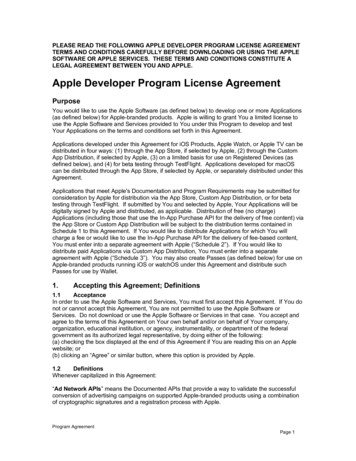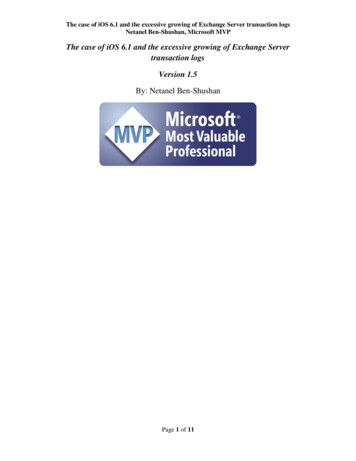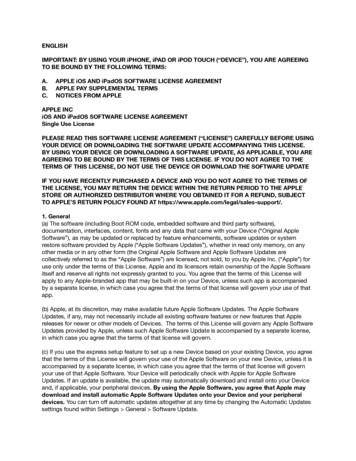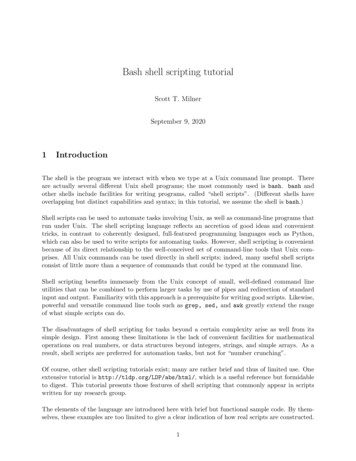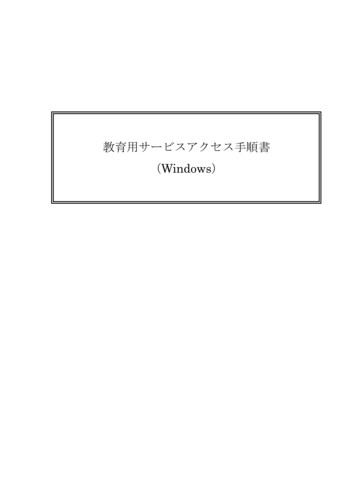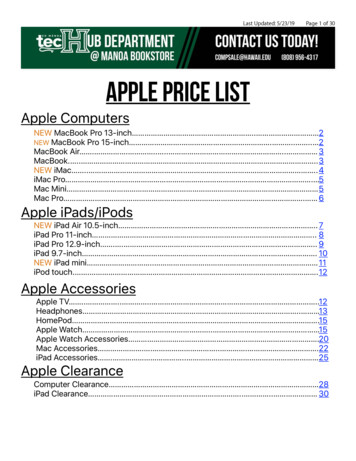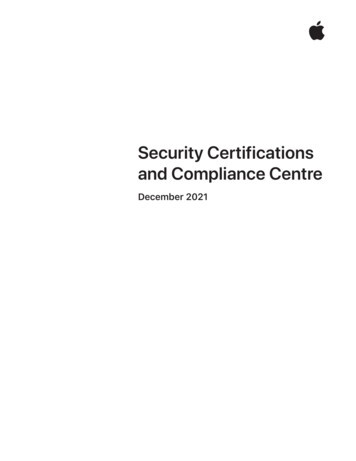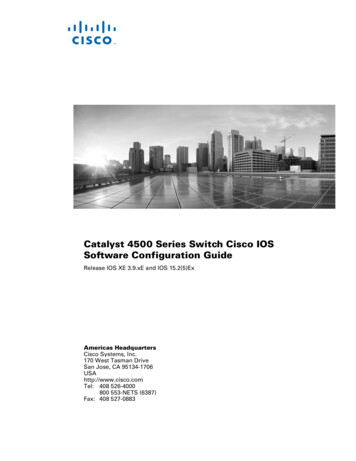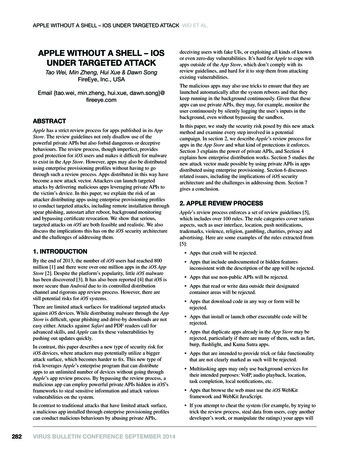
Transcription
APPLE WITHOUT A SHELL – IOS UNDER TARGETED ATTACK WEI ET AL.APPLE WITHOUT A SHELL – IOSUNDER TARGETED ATTACKTao Wei, Min Zheng, Hui Xue & Dawn SongFireEye, Inc., USAEmail {tao.wei, min.zheng, hui.xue, dawn.song}@fireeye.comABSTRACTApple has a strict review process for apps published in its AppStore. The review guidelines not only disallow use of thepowerful private APIs but also forbid dangerous or deceptivebehaviours. The review process, though imperfect, providesgood protection for iOS users and makes it difficult for malwareto exist in the App Store. However, apps may also be distributedusing enterprise provisioning profiles without having to gothrough such a review process. Apps distributed in this way havebecome a new attack vector. Attackers can launch targetedattacks by delivering malicious apps leveraging private APIs tothe victim’s device. In this paper, we explain the risk of anattacker distributing apps using enterprise provisioning profilesto conduct targeted attacks, including remote installation throughspear phishing, autostart after reboot, background monitoringand bypassing certificate revocation. We show that serious,targeted attacks on iOS are both feasible and realistic. We alsodiscuss the implications this has on the iOS security architectureand the challenges of addressing them.The malicious apps may also use tricks to ensure that they arelaunched automatically after the system reboots and that theykeep running in the background continuously. Given that theseapps can use private APIs, they may, for example, monitor theuser continuously by silently logging the user’s inputs in thebackground, even without bypassing the sandbox.In this paper, we study the security risk posed by this new attackmethod and examine every step involved in a potentialcampaign. In section 2, we describe Apple’s review process forapps in the App Store and what kind of protections it enforces.Section 3 explains the power of private APIs, and Section 4explains how enterprise distribution works. Section 5 studies thenew attack vector made possible by using private APIs in appsdistributed using enterprise provisioning. Section 6 discussesrelated issues, including the implications of iOS securityarchitecture and the challenges in addressing them. Section 7gives a conclusion.2. APPLE REVIEW PROCESSApple’s review process enforces a set of review guidelines [5],which includes over 100 rules. The rule categories cover variousaspects, such as user interface, location, push notifications,trademarks, violence, religion, gambling, charities, privacy andadvertising. Here are some examples of the rules extracted from[5]:1. INTRODUCTION Apps that crash will be rejected.By the end of 2013, the number of iOS users had reached 800million [1] and there were over one million apps in the iOS AppStore [2]. Despite the platform’s popularity, little iOS malwarehas been discovered [3]. It has also been reported [4] that iOS ismore secure than Android due to its controlled distributionchannel and rigorous app review process. However, there arestill potential risks for iOS systems. Apps that include undocumented or hidden featuresinconsistent with the description of the app will be rejected.There are limited attack surfaces for traditional targeted attacksagainst iOS devices. While distributing malware through the AppStore is difficult, spear phishing and drive-by downloads are noteasy either. Attacks against Safari and PDF readers call foradvanced skills, and Apple can fix these vulnerabilities bypushing out updates quickly.In contrast, this paper describes a new type of security risk foriOS devices, where attackers may potentially utilize a biggerattack surface, which becomes harder to fix. This new type ofrisk leverages Apple’s enterprise program that can distributeapps to an unlimited number of devices without going throughApple’s app review process. By bypassing the review process, amalicious app can employ powerful private APIs hidden in iOS’sframeworks to steal sensitive information and attack variousvulnerabilities on the system.In contrast to traditional attacks that have limited attack surface,a malicious app installed through enterprise provisioning profilescan conduct malicious behaviours by abusing private APIs,282deceiving users with fake UIs, or exploiting all kinds of knownor even zero-day vulnerabilities. It’s hard for Apple to cope withapps outside of the App Store, which don’t comply with itsreview guidelines, and hard for it to stop them from attackingexisting vulnerabilities.VIRUS BULLETIN CONFERENCE SEPTEMBER 2014 Apps that use non-public APIs will be rejected. Apps that read or write data outside their designatedcontainer areas will be rejected. Apps that download code in any way or form will berejected. Apps that install or launch other executable code will berejected. Apps that duplicate apps already in the App Store may berejected, particularly if there are many of them, such as fart,burp, flashlight, and Kama Sutra apps. Apps that are intended to provide trick or fake functionalitythat are not clearly marked as such will be rejected. Multitasking apps may only use background services fortheir intended purposes: VoIP, audio playback, location,task completion, local notifications, etc. Apps that browse the web must use the iOS WebKitframework and WebKit JavaScript. If you attempt to cheat the system (for example, by trying totrick the review process, steal data from users, copy anotherdeveloper’s work, or manipulate the ratings) your apps will
APPLE WITHOUT A SHELL – IOS UNDER TARGETED ATTACK WEI ET AL.be removed from the store and you will be expelled fromthe developer program. Apps that create alternate desktop/home screenenvironments or simulate multi-app widget experienceswill be rejected. Apps cannot transmit data about a user without obtainingthe user’s prior permission and providing the user withaccess to information about how and where the data will beused. Location data can only be used when directly relevant tothe features and services provided by the app to the user orto support approved advertising uses.Figure 1: Public Twitter APIs are called to post a Tweet on theuser’s Twitter page – the user must click the ‘post’ button.Apple uses the review process to prevent apps from conductingundesirable behaviours. However, if attackers can bypass thereview process, they can break all these rules and carry outmalicious behaviours that have severe security consequences ona victim’s device. For example, attackers can use iOS privateAPIs for powerful attacks.documented public APIs [14]. Table 1 lists several examples ofprivate APIs.Review process vs. private APIsApple forbids apps in the App Store from using private APIs,and bans app developers/vendors who do so. In February 2012,Apple banned all apps from Qihoo [6], a prominent Chineseanti-virus, web browser and search engine vendor. This majorincident happened because Qihoo used iOS private APIs andencrypted the function calls in its iOS apps – Apple has a policythat forbids any non-Apple apps in its App Store from usingprivate APIs.3. PRIVATE APIsiOS apps interact with the underlying system using ApplicationProgramming Interfaces (APIs). However, not all APIs areequally open to app developers. Apple forbids some of the APIs,known as ‘private APIs’, from being used in the apps on AppStore. Apple stipulates that these private APIs should only beused by the framework classes internally or by the iOS systemapps [5], and these private APIs remain undocumented.4. DISTRIBUTING IOS APPs THROUGHENTERPRISE PROVISIONINGPrivate APIs are considerably more powerful than their publicAPI counterparts. For example, on iOS 6.0, one app can callsome public Twitter APIs to post a Tweet on the user’s Twitterpage (Figure 1) and the user must consent by clicking the ‘post’button. On the contrary, by using private APIs, the app can postthe Tweet without notifying the user [8] at all.Besides the iOS App Store, iOS apps can also be distributedunder enterprise provisioning profiles to an unlimited number ofusers. The iOS Developer Enterprise Program [15] enables acompany to sign in-house apps with its enterprise distributioncertificate and distribute the apps to employees using enterpriseprovisioning profiles.Though Apple forbids the use of private APIs, and provides nodocumentation about them, an attacker can still obtain a list ofprivate APIs. To do so, one can begin by using otool [12] orclassdump [13] to obtain a complete list of APIs, both publicand private, from the iOS framework binaries shipped within theSDK. One can then obtain private APIs by subtracting theMethodIn practice, many app developers use this venue to distributeapps to the public [10]. As mentioned before, apps distributed inthis manner don’t have to go through Apple’s review process [5]and don’t have to conform to the rules in Apple’s guidelines y() Core telephonyUsageiOS 6.xiOS 7.xavailability availabilityGet Device IMSIYesNo[[UIDevice currentDevice] UniqueIdentifier]UIKitGet Device ingBoardServicesGet the array of current runningapp bundle IDsYesNo[[CTMessageCenter sharedMessageCenter]incomingMessageWithId: result]Core telephonyGet the text of the incoming SMS YesmessageYesMobileInstallationLookup()Mobile installationGet the bundle ID list of installediOS appsYesYesTable 1: Private API examples.VIRUS BULLETIN CONFERENCE SEPTEMBER 2014283
APPLE WITHOUT A SHELL – IOS UNDER TARGETED ATTACK WEI ET AL.library usage, privacy, user interface, etc. Thus, not only canthese apps freely use private APIs, they can also do other trickssuch as mimicking apps originally bundled with the device,such as App Store or iTunes Store, or creating alternative homescreen environments.Distributing apps using enterprise provisioning profilescombined with unregulated usage of private APIs creates a newattack vector that enables attackers to distribute malwareleveraging private APIs. Benign apps distributed underenterprise provisioning profiles also become valuable targets forattackers since many of them use private APIs.5. TARGETED ATTACKS THROUGHENTERPRISE PROVISIONINGFigure 2 shows the steps in a targeted attack using enterprisecertificates. Conceptually, the attacker first sends out a spearphishing email or SMS to the victim, who may be lured to clickon a link and install the app. Once the victim launches the app,it can leverage private APIs and some exploits to keepmonitoring the user, steal sensitive information in thebackground, and avoid being invalidated by Apple.4.1 Revocation of enterprise certificatesApple may revoke an enterprise distribution certificate, if itsuspects abuse. Revoking a distribution certificate invalidatesall of the apps that have been signed with it. Apple allows theenterprise apps to be used by employees of the developercompany only, rather than by everyone in the public. For thisreason, Apple revoked the enterprise distribution certificate ofQihoo, which released its ‘enterprise’ apps to the public [7].Apple uses the Online Certificate Status Protocol (OCSP) tovalidate enterprise certificates. According to the iOSDeployment Technical Reference [15], the first time a useropens an app distributed using the enterprise provisioningprofile, iOS contacts Apple’s OCSP server to validate itsdistribution certificate. A revoked distribution certificate willprevent the app from launching. The OCSP response will becached on the device for three to seven days [15]. However,‘inability to contact or get a response from the OCSP serverisn’t interpreted as a revocation’ [15]. That means iOS won’tprevent the app from launching if it can’t reach the OCSPserver.Figure 2: Targeted attacks against iOS through enterpriseprovisioning.4.2 Real-world apps distributed throughenterprise provisioningWe collected 1,408 apps from the Internet which weredistributed through enterprise provisioning. We parsed eachapp’s Info.plist file to determine its development region. Asshown in Table 2, most apps were from the United States,China, England and France.CountryNumber of appsUnited 8Table 2: App numbers by development region.Since these apps don’t go through Apple’s review process, theycan abuse the powerful private APIs. We found that, withinthese 1,408 apps, 844 (60%) used private APIs.284VIRUS BULLETIN CONFERENCE SEPTEMBER 2014Figure 3: Installing an enterprise app.
APPLE WITHOUT A SHELL – IOS UNDER TARGETED ATTACK WEI ET AL.5.1 Spear phishing through enterpriseprovisioningAn attacker may lure a victim to install an app through aspear-phishing email or SMS that contains a web link. Once theuser clicks on the link, there will be a pop-up letting the userinstall the app, as shown in Figure 3. If the user chooses toinstall and launch the app, it can, with the help of private APIs,keep monitoring the user and steal sensitive information in thebackground.5.2. Persistent monitoringAfter installation, the malicious app can monitor the victim’sactivity continuously, including on occasions when it isswitched to the background or the system reboots.In February 2014, we found a vulnerability in iOS private APIs[11] which meant that a malicious app making use of certainprivate APIs can monitor a user’s input. In this attack, amalicious app can use a private APIIOHIDEventSystemClientRegisterEventCallback() methodwithin IOKit.framework to register a callback to receivesystem-wide user input. This vulnerability can enable malwareto record all of the user’s touch/press events in the background,including touches on the screen, home button press, volumebutton press, and TouchID presses, as shown in Figure 4.Attackers can use such information to reconstruct everycharacter the victim inputs. Upon our notification, Apple issuedCVE-2014-1276 for this issue and pushed out a fix shortlyafterwards.While malware can use standard ‘background app refresh’ tomonitor the system continuously, iOS7 provides a setting for‘background app refresh’ that will disable unnecessarybackground refreshing, and may prevent malware from working.However, this can be bypassed. For example, an app can playmusic in the background without turning on its ‘background apprefresh’ switch. Thus a malicious app can disguise itself as amusic app to conduct background monitoring.On iOS, ordinary apps can’t start automatically after rebooting.However, VoIP apps are allowed to start automatically after thesystem reboot. Apple forbids non-VoIP apps in the App Storefrom using this feature. However, without being regulated byApple’s review process, the attacker can disguise a maliciousapp as a VoIP app, which enables the app to start automaticallyafter the device reboots, and thus monitor the victimcontinuously. Specifically, the malicious app can include the‘voip’ value in the UIBackgroundModes key so that the systemallows it to run in the background and launches it in thebackground again after system reboot.5.3 Disabling OCSPApple will validate the status of enterprise certificates roughlyevery three to seven days, at which point it has the chance offinding some abnormal behaviour and disabling thecorresponding apps. To prevent this, attackers can disable OCSP.Attackers may leverage existing exploits to modify the device’sOCSP cache to maintain a valid state for its certificate.Based on the findings from Wang et al. [16], under certainconditions, syslogd will do ‘chmod 777’ and ‘chown mobile’ to‘/var/mobile/Library/Logs/CrashReporter’. Thus, the maliciousapp can evade the sandbox and replace /var/mobile/Library/Logs/CrashReporter with a symbolic link to some other part ofthe system. This will be changed to writeable by syslogd, whichdoesn’t carry out proper checks on symbolic links. Themalicious app can then modify the OCSP cache to keep itsOCSP response valid all the time.5.4 Attacks by abusing private APIsPrivate APIs are powerful. However, since private APIs are notintended to be available to app developers, their design may nothave sufficient security considerations.Figure 4: Background monitoring.We have since found (and notified Apple about) another flaw oniOS 7 devices that enables telephone and SMS activity to bemonitored from the background. Malware can register acallback by using the ‘CTTelephonyCenterAddObserver’function in the CoreTelephony.framework and then it can recordall of the telephone and SMS events in the background,including incoming phone number, the SMS sender’s numberand SMS content, and then it can send all user events to anyremote server. In this way, malware can eavesdrop on sensitivecommunication and bypass two-factor authentication based onSMS.5.5 Attacks by deceptive behavioursThe App Store review guidelines [5] list many app behaviours asforbidden. However, these behaviours become possible for anapp distributed with enterprise provisioning. We list two caseswhere the attacker can break the guidelines for maliciousactivities. Attackers can do more based on their socialengineering techniques:VIRUS BULLETIN CONFERENCE SEPTEMBER 2014285
APPLE WITHOUT A SHELL – IOS UNDER TARGETED ATTACK WEI ET AL. A malicious app may create alternative home screenenvironments or mimic the apps bundled on iPhone, suchas App Store and iTunes Store. By doing so, the attackercan trick the user into using a fake iTunes Store app, andprompt the user to enter their password. For a user wholacks security knowledge, this phishing prompt may beenough for the attacker to steal the user’s Apple IDpassword successfully. A malicious app may also disguise itself as another popularapp and lure the user to use it. The attacker can embedmalicious code inside such fake apps to carry out furtherattacks.5.6 Attacks by using root exploitsIt’s known that Apple can’t fix all known vulnerabilities, or mayfix them incorrectly [16]. Malware installed through enterpriseprovisioning has more freedom to exploit known or zero-dayvulnerabilities. Attackers can even use dynamic codedownloading to prevent the exploit from being captured bysecurity vendors.6. DISCUSSION6.1 UDID and ad-hoc provisioningBesides enterprise certificates, apps can also be distributedusing ad-hoc provisioning. Compared with enterprisecertificates, ad-hoc distribution has the limitation that eachdevelopment account can only distribute to 100 devices permembership year. Each of the devices receiving apps will haveits unique device ID (UDID) registered in the ad-hocprovisioning profile to use the app.However, stealing the UDID from a target device on which theattacker wants to install a malicious app is not a hard job.Previously stealing the UDID may be treated just as privateinformation leakage. However, stealing the UDID is a cruciallink towards targeted attacks: attackers can use the UDID todeliver ad-hoc distributed apps to the victim’s phone.users from being infected by malware, there is still a big gap forenterprise security. Targeted attacks through enterpriseprovisioning pose a severe threat for enterprise users. Onceattackers compromise victims’ devices, they can access usefulinformation such as intellectual property, steal numerousaccounts of cloud services, and take photos or record audio/video through iOS devices.Currently, security on iOS runs into a dilemma: Apple doesn’tallow security vendors to implement system-level protections,whereas malware can freely call powerful private APIs andexploit vulnerabilities through enterprise provisioning.Furthermore, since most iPhones can access the Internet directlythrough their carriers (e.g. AT&T and Verizon) when they arenot connected to a company-managed wireless network, classicnetwork security devices in company networks can’t protectthese devices all the time.In the long run, Apple needs more investment in improvingenterprise-level security against advanced targeted attacks.Apple should consider bringing dedicated security vendorsinto its platform to help with enterprise-level securitysolutions.7. CONCLUSIONThough Apple enforces a rigorous review process forbiddingapps on App Store from conducting many dangerous/deceptivebehaviours, enterprise provisioning becomes a valid venue forapps to circumvent Apple’s regulations. Apps distributed usingenterprise provisioning profiles can abuse powerful privateAPIs, deceive users and exploit vulnerabilities, thus becoming asevere threat to enterprise users. Using these apps, an attackercan use a bigger attack surface to launch persistent and targetedattacks against the victim’s device. Apple may improve itsarchitecture to co-operate with security vendors in order toprovide a better enterprise-level security solution.REFERENCES[1]Tim Cook to shareholders: iPhone 5s/c outpacepredecessors, Apple bought 23 companies in 16months. at-shareholder-meeting-iphone-5s-5c- outpacepredecessors-apple-bought-23- companies-in-16months.[2]How Many Apps Are in the iPhone App /qt/appsin-app-store.htm.6.2 Abusing private APIs through bypassingreviewSince private APIs are loaded as framework code into the app’saddress space, together with the app developer’s own code,there are no obstacles to calling private APIs from a technicalperspective. Apple does prohibit doing so. However, works likeJekyll [8] have shown the possibility of bypassing Apple’sreview process.[3]Fooling Apple still has the risk of being banned once caught [6].However, since distributing apps using enterprise certificatesavoids the App Store, there’s no regulation on usage of privateAPIs. Currently, Apple doesn’t have an ideal way to superviseand manage these enterprise certificates.Felt, A. P.; Finifter, M.; Chin, E. Hanna, S.; Wagner,D. A survey of mobile malware in the wild. InProceedings of the 1st ACM workshop on Security andprivacy in smartphones and mobile devices, pp.3–14.ACM, 2011.[4]6.3 Challenges of iOS security architectureagainst targeted attacksWhen Malware Goes Mobile. http://www.sophos.com/en-us/security-news- trends/security-trends/malwaregoes- mobile/why-ios-is-safer-than-android.aspx.[5]App store review guidelines. roval/guidelines.html.While Apple does a good job of protecting ordinary App Store286VIRUS BULLETIN CONFERENCE SEPTEMBER 2014
APPLE WITHOUT A SHELL – IOS UNDER TARGETED ATTACK WEI ET AL.[6]Apple Bans Qihoo Apps From iTunes App Store.February 2012. ]Qihoo Double Blow as iOS Apps Banned by Apple,China Warns of Anti-Competitive Practices. January2013. pp-store/.[8]Wang, T.; Lu, K.; Lu, L.; Chung, S.; Lee, W. Jekyll oniOS: when benign apps become evil. Presented as partof the 22nd USENIX Security Symposium,pp.559–572, 2013.[9]CVE-2014-1276. http://support.apple.com/kb/HT6162.[10]How Apple’s Enterprise Distribution Program wasabused to enable the installation of a GameBoyemulator. 2014. http://www.imore.com/how-gameboyemulator- und Monitoring on Non-Jailbroken iOS 7Devices – and a Mitigation. nd-a-mitigation.html.[12]otool. tools-499/otool/.[13]classdump. http://stevenygard.com/projects/classdump/.[14]iOS Developer Library navigation/#section Resource%20Types&topic Reference.[15]iOS Deployment Technical docs/iOSDeployment Technical Reference EN May14.pdf.[16]Exploiting unpatched iOS vulnerabilities for fun andprofit. ofit.VIRUS BULLETIN CONFERENCE SEPTEMBER 2014287
and private, from the iOS framework binaries shipped within the SDK. One can then obtain private APIs by subtracting the documented public APIs [14]. Table 1 lists several examples of private APIs. Review process vs. private APIs Apple forbids apps in the App Store from using private APIs, and bans app developers/vendors who do so. In February .
